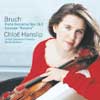Bruch Violin Concertos Nos 1 & 3
The lesser-known Bruch concerto finds this teenager meeting a bigger challenge
View record and artist detailsRecord and Artist Details
Composer or Director: Max Bruch, Pablo (Martín Melatón) Sarasate (y Navascuéz)
Genre:
Orchestral
Label: Erato
Magazine Review Date: 12/2002
Media Format: CD or Download
Media Runtime: 70
Mastering:
Stereo
DDD
Catalogue Number: 0927-45664-2

Tracks:
| Composition | Artist Credit |
|---|---|
| Concerto for Violin and Orchestra No. 1 |
Max Bruch, Composer
Chloë Hanslip, Violin London Symphony Orchestra Martyn Brabbins, Conductor Max Bruch, Composer |
| Concerto for Violin and Orchestra No. 3 |
Max Bruch, Composer
Chloë Hanslip, Violin London Symphony Orchestra Martyn Brabbins, Conductor Max Bruch, Composer |
| Navarra |
Pablo (Martín Melatón) Sarasate (y Navascuéz), Composer
Chloë Hanslip, Violin London Symphony Orchestra Martyn Brabbins, Conductor Mikhail Ovrutsky, Violin Pablo (Martín Melatón) Sarasate (y Navascuéz), Composer |
Author: Edward Greenfield
Having in her impressive first disc offered a sequence of violin lollipops (11/01), Chloë Hanslip here goes far farther in demonstrating her artistry in far more demanding repertory, defying any idea that a teenaged virtuoso has to be judged by less stringent standards. The coupling of the First and Third Bruch Violin Concertos on a single disc is attractive and currently unique. The disc even suggests that the bigger the challenge for this young soloist, the greater her success.
The popular G minor work comes in a warm confident reading, which is impressive enough, but the far more demanding D minor, almost twice as long, finds her even more confident, both more imaginative and more individual. If in the much-duplicated G minor she sounds rather effortful next to such an artist as Tasmin Little – often underlining her phrasing too emphatically, and not helped by her close balance in the otherwise full and brilliant recording – such reservations are dispelled in the D minor.
With Martyn Brabbins drawing incisive playing from the LSO, rather crisper than that of the same orchestra on the rival Chandos disc, this is a performance of No 3 in which Hanslip sounds as though she has lived with this work so completely that the phrasing comes spontaneously, with fine, clean attack, flawless intonation and wonderfully crisp and clear double-stopping.
In this expansive Concerto, written in 1891, almost 30 years after the G minor, there is always the danger that the writing will come to sound ponderous and square, but like Lydia Mordkovitch on the Chandos version, Hanslip conveys freshness and spontaneity. She plainly revels in the beauty of the violin-writing and its range of expression, with formidable bravura set against moments of pure poetry, as in the ethereally high entry of the soloist in the first movement (4'33" into track 4) or the poised and tender close of the central slow movement.
She is more poetic in that slow movement than she is in the central Adagio of No 1, and similarly the finale, with its main theme in compound time hinting at folk music, sparkles more than the equivalent movement of No 1 where her playing lacks the playfulness that Tasmin Little finds.
No one wanting this unique coupling need hold back over any marginal reservations in No 1. The disc is generously rounded off with a delightful bonus in the Sarasate Navarra for two violins and orchestra, with Mikhail Ovrutsky perfectly matched in jaunty Spanish dance rhythms.
The popular G minor work comes in a warm confident reading, which is impressive enough, but the far more demanding D minor, almost twice as long, finds her even more confident, both more imaginative and more individual. If in the much-duplicated G minor she sounds rather effortful next to such an artist as Tasmin Little – often underlining her phrasing too emphatically, and not helped by her close balance in the otherwise full and brilliant recording – such reservations are dispelled in the D minor.
With Martyn Brabbins drawing incisive playing from the LSO, rather crisper than that of the same orchestra on the rival Chandos disc, this is a performance of No 3 in which Hanslip sounds as though she has lived with this work so completely that the phrasing comes spontaneously, with fine, clean attack, flawless intonation and wonderfully crisp and clear double-stopping.
In this expansive Concerto, written in 1891, almost 30 years after the G minor, there is always the danger that the writing will come to sound ponderous and square, but like Lydia Mordkovitch on the Chandos version, Hanslip conveys freshness and spontaneity. She plainly revels in the beauty of the violin-writing and its range of expression, with formidable bravura set against moments of pure poetry, as in the ethereally high entry of the soloist in the first movement (4'33" into track 4) or the poised and tender close of the central slow movement.
She is more poetic in that slow movement than she is in the central Adagio of No 1, and similarly the finale, with its main theme in compound time hinting at folk music, sparkles more than the equivalent movement of No 1 where her playing lacks the playfulness that Tasmin Little finds.
No one wanting this unique coupling need hold back over any marginal reservations in No 1. The disc is generously rounded off with a delightful bonus in the Sarasate Navarra for two violins and orchestra, with Mikhail Ovrutsky perfectly matched in jaunty Spanish dance rhythms.
Discover the world's largest classical music catalogue with Presto Music.

Gramophone Digital Club
- Digital Edition
- Digital Archive
- Reviews Database
- Full website access
From £8.75 / month
Subscribe
Gramophone Full Club
- Print Edition
- Digital Edition
- Digital Archive
- Reviews Database
- Full website access
From £11.00 / month
Subscribe
If you are a library, university or other organisation that would be interested in an institutional subscription to Gramophone please click here for further information.




